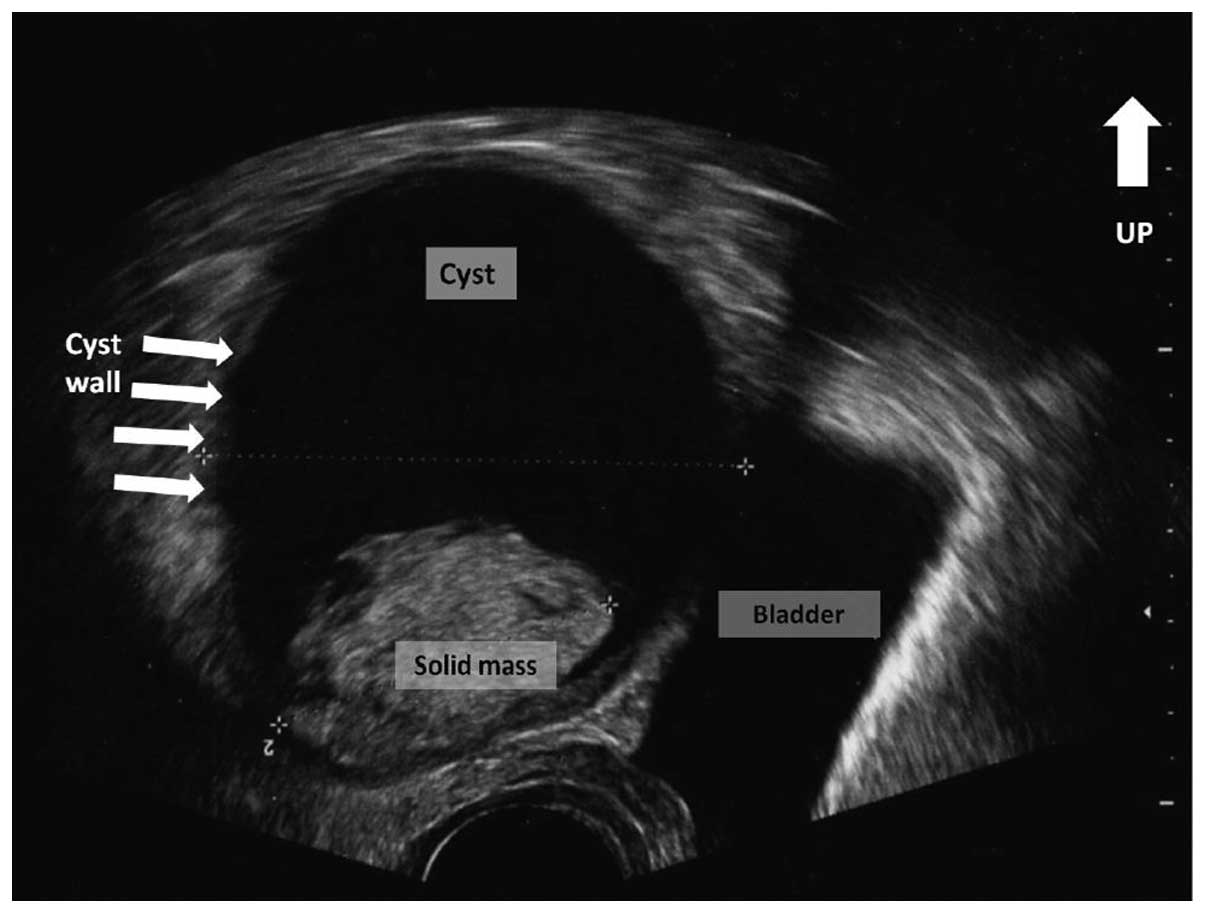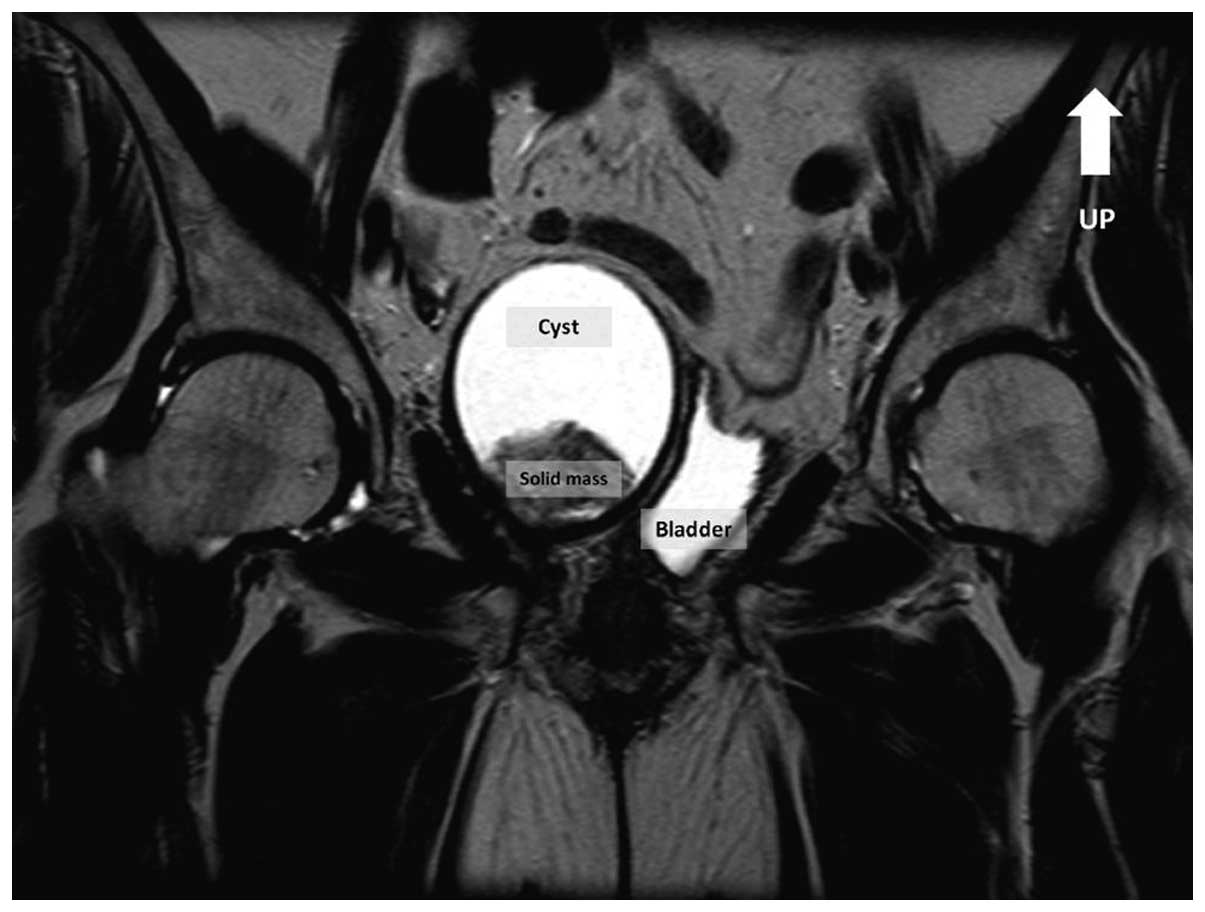Introduction
Surgicel® (Johnson & Johnson Medical
Ltd., Wokingham, UK) is an absorbable sterile mesh composed of
oxidized cellulose, which is used to control intraoperative
capillary or venous bleeding (1).
Surgicel® binds hemoglobin, allowing the formation of an
artificial clot (2). Although the
manufacturer recommends its removal following achievement of
hemostasis, Surgicel® is frequently left in situ
to reabsorb spontaneously, typically with no untoward effects
(3).
Adverse reactions to Surgicel® include
burning, stinging sensation or, more rarely, a foreign body
reaction (4,5). It has been reported that 40% of foreign
body reactions are diagnosed within the initial year subsequent to
surgery, and 50% are discovered ≥5 years following surgery
(6–8).
The majority of these complications occur outside the abdominal
cavity, and a limited number of cases of
Surgicel®-associated granuloma linked to gynecological
surgery have been reported thus far (6–8).
The present study reports a case of
Surgicel®-associated granuloma mimicking ovarian cancer
following a combined pubovaginal sling procedure and cystocele
repair, and reviews the literature concerning this rare
pathological condition. Written informed consent was obtained from
the patient.
Case report
In June 2012, a 67-year-old Caucasian woman
underwent a combined pubovaginal sling procedure and cystocele
repair at the Department of Urology and Renal Transplantation,
University of Foggia (Foggia, Italy), using a large graft of
autologous rectus muscle fascia, for the treatment of anterior
genital prolapse with urinary stress incontinence. A
Surgicel® bolster purchased from Johnson & Johnson
Medical Ltd., was placed in each perivesical space to achieve
hemostasis. The postoperative course was uneventful. At six-month
follow-up, the patient complained of irritative voiding symptoms,
which had progressively increased over the previous month. Urine
culture was negative. Pelvic and transvaginal ultrasound revealed
an 89-mm cystic lesion, with a 37-mm hyperechoic area on its wall,
located in the right perivesical space (Fig. 1). Magnetic resonance imaging (MRI)
confirmed the presence of a cystic lesion with a thick solid inner
area (Fig. 2). The cystic walls
presented intense contrast enhancement, whereas the solid area did
not exhibit any increase in signal following administration of
gadolinium (MultiHance®, Bracco Diagnostics Inc., Monroe
Township, NJ, USA). There was no sign of bladder or rectal invasion
and no apparent lymph node involvement. The level of CA125 serum
tumor marker was 10 U/ml, which was within the normal range (<35
U/ml). Transperitoneal laparoscopic exploration revealed a large
extraperitoneal mass arising from the right perivesical space and
compressing the right ovary, which was normal in appearance. The
mass was excised, and was observed to contain dark-brown
particulate matter. Pathological examination revealed the presence
of a large plasma cellular and granulocytic reaction, suggesting
the occurrence of a foreign body reaction around the cellulose
fibers (data not shown). Diagnosis of a
Surgicel®-associated abscess was established, and one
month subsequent to surgery the irritative voiding symptoms
experienced by the patient had completely ceased.
Discussion
Intraoperative use of adjuvant hemostatics has
become a common practice in gynecological and other types of
surgery (2). Surgicel® is
frequently used for hemostasis in a number of surgical procedures
(2). Absorption of
Surgicel® commences within 24 h following surgery, and
complete resorption typically occurs within 4–8 weeks (9). It is common for oxidized cellulose to
appear as a mass during the immediate postoperative period, and
this should not be confused with a postoperative abscess (9), tumor (10)
or hematoma (11). Radiological
features are nonspecific, and differential diagnosis may be
particularly difficult, as the lesion may exhibit a tumor-like
appearance (12).
The computed tomography (CT) features of
Surgicel®-associated granuloma include focal or linear
collections of mixed attenuation located in or near the operative
site, as well as pockets of air and absence of contrast enhancement
and air-fluid levels (9). Over time,
these pockets of air are completely replaced by soft tissue,
leading to the formation of a foreign body granuloma (9). This granuloma may clinically and
radiologically resemble a neoplastic lesion, and may therefore be a
diagnostic challenge (6).
MRI findings are nonspecific, although the presence
of hypointense stripes inside a cystic-like cavity on T2 weighted
images is considered to be a characteristic sign of
Surgicel®-associated granuloma (13). Despite the high accuracy of positron
emission tomography (PET)/CT scanning, this method may produce
false-positive results in cases of foreign body granuloma, possibly
as a consequence of localized inflammation mimicking malignant
tissue glucose uptake (14).
Imperiale et al (8) reported
the case of a patient with ovarian cancer where combined
18F-fluorodeoxyglucose PET/CT suggested isolated cancer
relapse. However, the lesion was surgically removed and
demonstrated to be a foreign body granuloma (8).
The present case has been reported in order to alert
surgeons to the risk of using and leaving in situ oxidized
cellulose. Furthermore, accurate evaluation of the surgical history
of the patient should always be performed prior to attempting
surgery.
References
|
1
|
Achneck HE, Sileshi B, Jamiolkowski RM,
Albala DM, Shapiro ML and Lawson JH: A comprehensive review of
topical hemostatic agents: Efficacy and recommendations for use.
Ann Surg. 251:217–228. 2010. View Article : Google Scholar : PubMed/NCBI
|
|
2
|
Hadi HI, Maw A and Hay DJ: A simple
technique to control iatrogenic solid organ injury haemorrhage.
Surgeon. 2:339–361. 2004. View Article : Google Scholar : PubMed/NCBI
|
|
3
|
Sabel M and Stummer W: The use of local
agents: Surgicel and Surgifoam. Eur Spine J. 13(Suppl 1): S97–S101.
2004. View Article : Google Scholar : PubMed/NCBI
|
|
4
|
Rappaport W and Haynes K: The retained
surgical sponge following intra-abdominal surgery. A continuing
problem. Arch Surg. 125:405–407. 1990. View Article : Google Scholar : PubMed/NCBI
|
|
5
|
Buckley SC and Broome JC: A foreign body
reaction to Surgicel(R) mimicking an abscess or tumour recurrence.
Br J Neurosurg. 9:561–563. 1995. View Article : Google Scholar : PubMed/NCBI
|
|
6
|
Deger RB, LiVolsi VA and Noumoff JS:
Foreign body reaction (gossypiboma) masking as recurrent ovarian
cancer. Gynecol Oncol. 56:94–96. 1995. View Article : Google Scholar : PubMed/NCBI
|
|
7
|
Gao HW, Lin CK, Yu CP, Yu MS and Chen A:
Oxidized cellulose (Surgicel) granuloma mimicking a primary ovarian
tumor. Int J Gynecol Pathol. 21:422–423. 2002. View Article : Google Scholar : PubMed/NCBI
|
|
8
|
Imperiale L, Marchetti C, Salerno L,
Iadarola R, Bracchi C, Vertechy L, di Francesco L, Musella A,
Bevilacqua E, Pennesi P, et al: Nonabsorbable suture granuloma
mimicking ovarian cancer recurrence at combined positron emission
tomography/computed tomography evaluation: A case report. J Med
Case Rep. 8:2022014. View Article : Google Scholar : PubMed/NCBI
|
|
9
|
Young ST, Paulson EK, McCann RL and Baker
ME: Appearance of oxidized cellulose (Surgicel) on postoperative CT
scans: Similarity to postoperative abscess. AJR Am J Roentgenol.
160:275–277. 1993. View Article : Google Scholar : PubMed/NCBI
|
|
10
|
Sandhu GS, Elexpuru-Camiruaga JA and
Buckley S: Oxidized cellulose (Surgicel) granulomata mimicking
tumour recurrence. Br J Neurosurg. 10:617–619. 1996. View Article : Google Scholar : PubMed/NCBI
|
|
11
|
van Gelderen F and Swinnen J: Appearance
of oxidized cellulose (Surgicel) on abdominal radiographs. AJR Am J
Roentgenol. 167:15931996. View Article : Google Scholar : PubMed/NCBI
|
|
12
|
Kim SR, Baik HK and Park YW: Retained
surgical sponge presenting as a pelvic tumor after 25 years. Int J
Gynaecol Obstet. 82:223–225. 2003. View Article : Google Scholar : PubMed/NCBI
|
|
13
|
Oto A, Remer EM, O'Malley CM, Tkach JA and
Gill IS: MR characteristics of oxidized cellulose (Surgicel). AJR
Am J Roentgenol. 172:1481–1484. 1999. View Article : Google Scholar : PubMed/NCBI
|
|
14
|
Ghersin E, Keidar Z, Brook OR, Amendola MA
and Engel A: A new pitfall on abdominal PET/CT: A retained surgical
sponge. J Comput Assist Tomogr. 28:839–841. 2004. View Article : Google Scholar : PubMed/NCBI
|
















